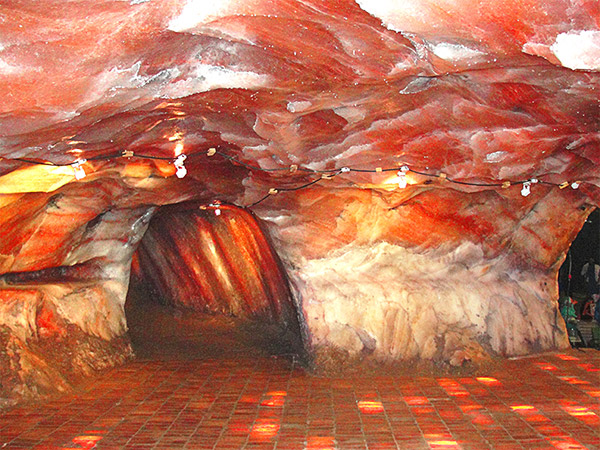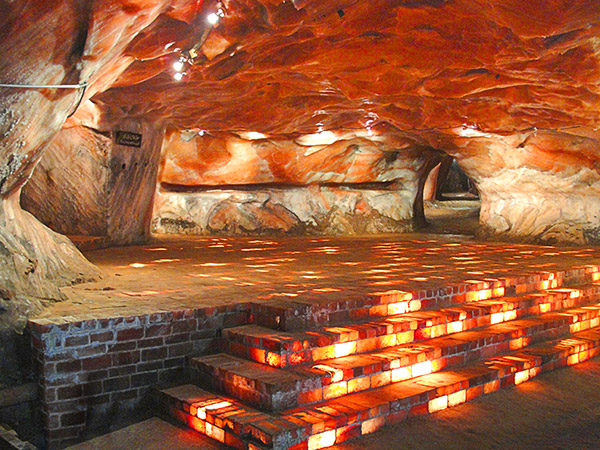Is Himalayan Salt Sustainable?

The short answer is yes. Himalayan salt is a natural product containing trace minerals that are also present in our bodies. The salt is mined by hand by skilled workers using traditional methods, so there's little to no pollution or waste byproducts from manufacturing.
Though Himalayan pink salt was formed millions of years ago, the six mines where the salt is harvested each contain vast supplies. The total number is disputed, but by some estimates the largest mine, Khewra, holds 6.7 billion tons, of which about 220 million tons is currently accessible. Khewra harvests about 400,000 tons per year, which means one mine could continue harvesting at a similar rate, without expansion, for about 550 more years! If tunnels and mining expanded further into the mountains, the supply could be nearly infinite.
A Brief History of Himalayan Salt Mining
The story of Himalayan salt begins more than 500 million years ago in the formative Precambrian era. An ancient inland sea slowly evaporated, leaving behind expansive mineral salt deposits. As tectonic activity shifted the earth, the seabed was hermetically sealed, buried under intense pressure. As the continents continued to shift, the rock surrounding the seabed was forced upward, forming the mountain ranges where the mines are now located.
The salt deposits were first discovered centuries later around 326 BC when Alexander the Great and his soldiers stopped to rest in the Khewra region in what is now Northern Pakistan. One member of the group noted their tired and hungry horses had gathered around and were licking the salty rocks.
Centuries after this initial discovery, the Mughal emperor Jalaluddin Muhammad Akbar introduced standardized salt mining in Khewra. While many historians believed the salt was mined in small quantities by local communities, it wasn't until the reign of Emperor Akbar that this pink, mineral-rich salt became a traded commodity.
In 1827, a British engineer established a sustainable excavation model called âÂÂRoom and Pillarâ (or âÂÂDome and PillarâÂÂ) which gave rise to modern mining and increased harvesting.
Himalayan salt is still hand-harvested by skilled workers who use these time-honored methods and techniques established under Akbar and the British.
Where Does Himalayan Salt Come From?
 There are many rooms in the mine where we source Ancient Ocean® Himalayan Pink Salt. Tunnels in the mine extend two miles into the mountain.
There are many rooms in the mine where we source Ancient Ocean® Himalayan Pink Salt. Tunnels in the mine extend two miles into the mountain. The Salt Range begins in the foothills of the Himalayan Mountains in Northeast Pakistan and stretches across approximately 186 miles from the Jhelum River to the Indus River. The range varies in width from 5 to 19 miles and includes several peaks nearly 5,000 feet high. There are six primary mines scattered across the Salt Range and each produces unique, varied and distinct salts.
The Khewra Salt Mine (also sometimes called the Mayo Salt Mine) is the most well-known, largest and also the oldest in the Salt Range. It produces most of the salt we've come to know as Himalayan Salt with the range of light-to-dark pink coloring.
Established in the 1820s, this mine extends through 25 miles of tunnels across 18 working levels. A major tourist attraction, it draws nearly 300,000 visitors to Pakistan each year with its unique artistic salt carvings of famous monuments including miniature replicas of the Eiffel Tower and the Great Wall of China as well as a small mosque and a bridge built entirely from salt blocks that extends over a salt brine pond.
The mine where SaltWorks sources Ancient Ocean is trade secret. We have built a strong relationship and have an exclusive partnership with a reputable and trusted mining company from whom we source all of our Himalayan Pink Salt. This salt vendor is registered with the FDA, in full compliance with the Bioterrorism Act of 2002, and shares our commitment to quality and high production standards. The mine is overseen by the Pakistan Mining Development Corporation which ensures that no child or slave labor is used and miners are provided fair wages, medical care and education.
Environmental Impact of Himalayan Salt Mining
Himalayan salt is harvested using the âÂÂRoom and Pillarâ (also called âÂÂDome and PillarâÂÂ) architectural system established by the British in the early 1800s. This method supports the sustainability (and safety) of the mines. Only 50 percent of the salt in each âÂÂroomâ within the mine is harvested and removed. The remaining 50 percent is left as pillars to support the structure of the rooms and the mountain.
The use of dynamite or explosives is often a concern. Explosives are only used for the initial opening of the entrance to the mine (this process occurred more than a hundred years ago for the six established mines in the Salt Range). All mining of Himalayan salt is done by hand using traditional, established methods. Though this is a slow process, the use of explosives within the mine is prohibited to protect the crystal structure of the salt. No known wildlife or plant life is affected by the salt mining.
When the salt arrives in Our Facility in Washington State, it goes through our multi-step proprietary Optically Clean® process to remove contaminants, foreign matter, and less-than-ideal crystals, leaving only the purest, cleanest and brightest colored Ancient Ocean Himalayan Pink Salt available. Our salt is never chemically treated or refined, leaving intact the rich mineral content for which it's loved and prized.
Community Impact of Himalayan Salt Mining
Salt is a major trade commodity. Communities are built around the mines across the Salt Range. Relying on the environment for hundreds of years, Himalayan salt became one of the region's most valuable agricultural products. Their time-honored tradition as salt workers and the sustainable culture built around it remains a valued piece of Pakistan's history and agricultural past and present.
We work closely with our suppliers to facilitate the growth of this emerging market and ensure that workers are supported. As a member of Sedex (Supplier Ethical Data Exchange), we're committed to bolstering the principals of ethical sourcing and we make sure our suppliers provide fair wages and do not use slave or child labor.
The salt mines are managed by the Pakistan Mineral Development Corporation which ensures that workers are paid fair wages and the working conditions are humane. This corporation, as well as the individual mining companies, provide employment opportunities, free medical care, education and community support as well as supporting environmental sustainability.
